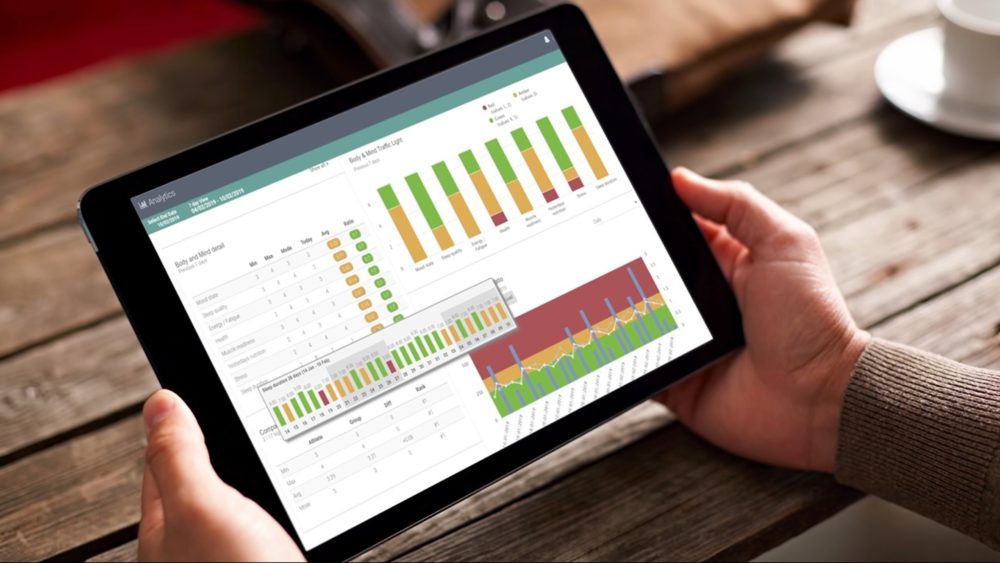Are you asking the right questions to assess the well being of your athletes?

One of the key elements of athlete monitoring in recent times has been the ability to assess the wellness of the individual. Being able to pinpoint an athlete’s physical well-being is obviously essential but in the sporting world where fractions of seconds and millimetres can make all the difference, general well being can be a vital factor in getting the most out of a training/practice session or competitive performance.
It can also be a significant factor, through early intervention, in helping to prevent injury and fatigue – issues which can have a hugely detrimental effect on an athlete. Monitoring an athlete helps us to learn about their patterns of behavior and habits. Capturing that data allows the coach to evaluate it and analyse it, which in turn helps them get the best possible performance out of the athlete. For those involved in the development of programs to assist athlete self report measures (ASRM), one key thing is to come up with the right questions in the appropriate format in order to get the most accurate information possible. The second key thing is to make sure you act on the data to inform decision making and change.
Encourage ‘buy-in’ from athletes
Making your athletes part of the process is a key element of ensuring buy-in. The challenge is to deliver a set of questions that are broad enough to collect all the necessary information, yet at the same time are not too complicated for the athlete to follow, or too time consuming. Otherwise, it will be difficult for the athlete to ‘buy-in’ to the system. In Monitoring the athlete training response: subjective self-reported measures trump commonly used objective measures: a systematic review Anna E Saw, Luana C Main and Paul B Gastin provide us with an overview of some of the main challenges in ensuring the appropriate questions are being posed. They warn that the one of the most important objectives of an ASRM is to reduce the concepts of measurement-error and conscious bias which can severely limit the accuracy of self-reporting.
Conscious bias is often the result of an individual responding in a socially desirable manner, generally over-reporting favorable responses and under-reporting unfavorable responses. In the sports setting, this may mean athletes ‘faking good’ to appear to be coping or to gain selection, or ‘faking bad’ to have their training reduced. Therefore it is important to not only consider the design of a self-report measure, but also the individual and situational factors which may influence the ability to obtain meaningful, accurate and consistent data from athletes

The process needs to be user-friendly and not take up too much of the athlete’s time. Once coaches are able to view information based on their athletes completing daily questionnaires, it is important follow up and feedback if appropriate. If an athlete fills in every day for a week that he/she is stressed, anxious, not sleeping and nobody does anything about it- it sends a message that the data is not important. If they have no education on how monitoring is being used and how important it is for their particular program compliance will become an issue. Education and Feedback are integral parts of the process. Building accountability and trust on both sides is the recipe to success.
Benefits of asking the right questions
The questions asked should be relevant to the athlete. It is important that education goes hand-in-hand with the introduction of a monitoring system. They athletes need to know why they are using it, what benefit it is to them, how it will help them and how the information will be used.It is important to make it as easy as possible for the athlete to provide accurate information, as summed up by Anna Saw
Questions which seemed irrelevant to the athlete and their sport were a barrier to compliance whereas ambiguity compromised accuracy, as exemplified by an athlete’s comment: ‘I don’t really know what general health is compared to sickness’. Athletes preferred to respond quickly on scales rather than enter text, however they expressed concern of being compared against other athletes who may interpret a scale differently. Due to these limitations, the ability to also enter explanatory comments was perceived as valuable by athletes and staff
In The use of wellness questionnaires in football, the Barça Innovation Hub state
In sports such as football, where each team has 20 to 25 players, it is not viable to talk to each one of them on a daily basis to see how they feel, how they slept, or how fatigued they feel. Wellness questionnaires allows us to obtain this valuable information in a fast, easy-to-process way without requiring an individual conversation with each member of the group. The use of these questionnaires is therefore growing exponentially. In fact, they’re now considered the second most important monitoring tool for injury prevention among the teams’ head medical officers included in the UEFA Elite Club Injury Study (Figure 1) (McCall et al., 2016).
They go on to say that it is vital to explain to players the importance of honesty when filling out any wellness questionnaire. Player health and well-being should be at the fore and players shouldn’t be concerned about the assessment having an impact on their participation in the next game. Honesty and trust in the process is key. Over time players will see the co-relation between their wellness and performance and become more self-aware about the importance of sleep hygiene and how stress and anxiety can affect their performance.
Metrifit Ready to Perform
Metrifit Ready to Perform (RTP) has taken all this into consideration and through provision of feedback and analytics aims to promote self-awareness and accountability on behalf of the athlete.
In the words of one of our clients
One of the great things about Metrifit is the intuitive layout of the app, for both players and coaches. For players, the sliding scale makes it easy to fill out, and on the other end, the traffic light system makes it quick and easy to interpret the scores, with red flags coming to the top so it’s the first thing you see. The ability for players to add comments give us an even greater insight – Cairbre Ó Cairealláin

A short summary of how Metrifit works:-
- Athletes are reminded to fill in their daily questionnaire
- Questions are answered for the most part on a sliding scale of 1- 5. Responses indicating an issue trigger additional questions and free format feedback areas
- Completing the questionnaire/survey takes the athlete between 30 – 60 seconds each morning
- Questions cover key areas such as mood state, sleep quality & duration, muscle soreness, energy levels, stress, health, nutrition and activity duration and intensity
- Invaluable information is provided to coaches by computing a ‘readiness to perform’ score which becomes more intelligent over time as the athlete inputs more data. It also includes acute:chronic workload ratio alerts based on recent research from Tim Gabbett which highlights injury risk where training spikes are evident
- Coaches can view individual athlete information as well as daily traffic light reports which highlight risk factors for athletes
- An internal messaging system and Coaches Corner knowledge library which allows for categorization and distribution of key information provides an excellent communication platform
- Athletes and Coaches can export all data for input into other programs
- Descriptive analytics uses a series of statistical functions to highlight deviation from normal behavior as well as highlighting areas of concern and at risk athletes. This is presented visually to allow coaches to view at risk athletes easily and action effectively.
- GPS integration as well as uploading of test results is also included
Life Style Profiling
Like anything you want to monitor, it is important initially to know what your baselines are. What are your team’s weaknesses and strengths? How can you educate your athletes and encourage good lifestyle habits that help improve the performance of every athlete on your team? Educating and empowering athletes to make informed decisions to improve their lifestyle can pay huge dividends on the playing field. Metrifit’s lifestyle profiling provides invaluable insight into the well-being of your team with clear visuals that help you make informed decisions to prepare your athletes for optimal performance.
About Metrifit
Metrifit is an athlete monitoring system that gathers subjective and objective information from both coaches and athletes to drive behavior modification and improvement through insights modeled on descriptive and predictive analytics. It sounds complicated but Metrifit prides itself on its simple intuitive interface and advocates a simple effective approach that doesn’t overwhelm the athlete or the coaching/staff member. It has received high praise for its intuitive interface and it allows monitoring to be scaled for all levels of athletes and teams. Our ethos is ‘simple but effective’ and our suite of products are parameter driven and easily customizable and configurable for different clients as required. Metrifit is ‘athlete-centric’ helping to develop self-awareness, encourage creative thinking and emotional intelligence as well as developing ownership and responsibility within the athlete for their own success. To find out more information please visit Metrifit Overview or contact us at
The use of wellness questionnaires in football | Barca Innovation Hub

 Previous Post
Previous Post Next Post
Next Post





